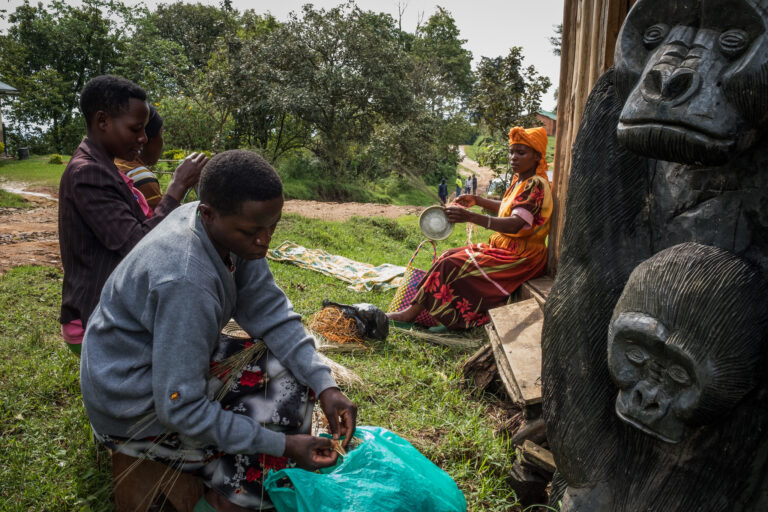- Great apes are on track to lose 94% of their range to climate change by 2050 if humans do nothing to address the problem, according to research.
- In the great apes stronghold of the Congo Basin, national interests in natural resource exploitation, a lack of security in areas like the Albertine Rift, hunting, and the illegal wildlife trade all greatly impact populations of bonobos and mountain gorillas.
- In this episode of Mongabay Explores, Gladys Kalema-Zikusoka, Kirsty Graham, Terese Hart, and Sally Coxe speak with Mongabay about the threats to bonobos and mountain gorillas, the lessons learned from decades of conservation efforts, the importance of great apes for the protection of Congo Basin rainforest, and ways forward for conservation as well as livelihoods for Indigenous and local communities.
On this episode of the Mongabay Explores podcast, Terese Hart, a researcher with the ICCN (the Congolese Institute for the Conservation of Nature); Gladys Kalema-Zikusoka, a wildlife veterinarian and founder of the NGO Conservation Through Public Health; Kirsty Graham, a researcher from the University of St Andrews; and Sally Coxe, co-founder and president from the Bonobo Conservation Initiative, speak with Mongabay about the state of conservation for bonobos and mountain gorillas in the Congo Basin.
Additionally, they detail the complicating factors of violence and instability in the Albertine Rift (the primary habitat of mountain gorillas) and a very difficult road ahead to protect great apes in the face of climate change and competing national interests for natural resources in and around the land in which they live.
Listen here:
Mountain gorillas (Gorilla beringei beringei) are the only great ape species known to be increasing in population in recent years, rebounding enough to become upgraded on the IUCN Red List from critically endangered to endangered in 2018. But this success comes with the added complication of less and less habitat for them. Research suggests a correlation between this confinement and a rise in disease and infant mortality.

According to Kalema-Zikusoka, tourism has greatly benefited conservation for mountain gorillas and provided income for local communities; however, this model is not so easily applied everywhere, particularly in the Democratic Republic of the Congo, where violence makes ecotourism investment a risky prospect.
“For tourism, there has to be no conflict; it’s very difficult for anyone to go there [the DRC] if you know that you may not come out alive,” Kalema-Zikusoka says.
Bonobos (Pan paniscus) continue to face hunting threats as well as illegal wildlife trafficking. Endemic to the DRC, this species was influential in the establishment of Lomami National Park, a key bonobo habitat, and the first national park established after a 40-year gap. But how to carry out conservation moving forward is a topic of discussion among conservationists.

While many acknowledge the importance and necessity of community involvement and granting land rights to Indigenous communities, the guests stress the importance of tailored management plans, careful consultations with Indigenous groups and ongoing support for communities involved.
“You have to have something that will persist through generations … that won’t have the same likelihood of success in one area as it will in another area,” says Hart.

Complicating this further is the push to increase natural resource exploitation in the DRC. The government has opened up 27 blocks of land in the nation for oil and gas exploration, putting many national parks, and lands upon which great apes rely on, at risk of disruption.
“At the end of the day, it’s one of the poorest countries in the world. They need to feed their people. … It’s very, very sad, but there has to be something; there has to be an economic activity that lifts them out of poverty that’s compatible with conservation,” says Kalema-Zikusoka.
Subscribe to or follow Mongabay Explores wherever you get podcasts, from Apple to Spotify, and you can also listen to all episodes here on the Mongabay website, or download our free app for Apple and Android devices to gain instant access to our latest episodes and all our previous ones.
Listen to the previous episode in this podcast series here:
Sounds heard during the intro and outro: The call of a putty-nosed monkey (Cercopithecus nictitans). This soundscape was recorded in Ivindo National Park in Gabon by Zuzana Burivalova, Walter Mbamy, Tatiana Satchivi and Serge Ekazama.
Banner image: Uganda’s Bwindi Impenetrable National Park is a sanctuary for half of the world’s remaining population of endangered mountain gorillas, alongside forest elephants and many other species. Image by Brian Harries via Flickr (CC BY 2.0).
Mike DiGirolamo is Mongabay’s audience engagement associate. Find him on Twitter @MikeDiGirolamo, Instagram, TikTok and Mastodon.
